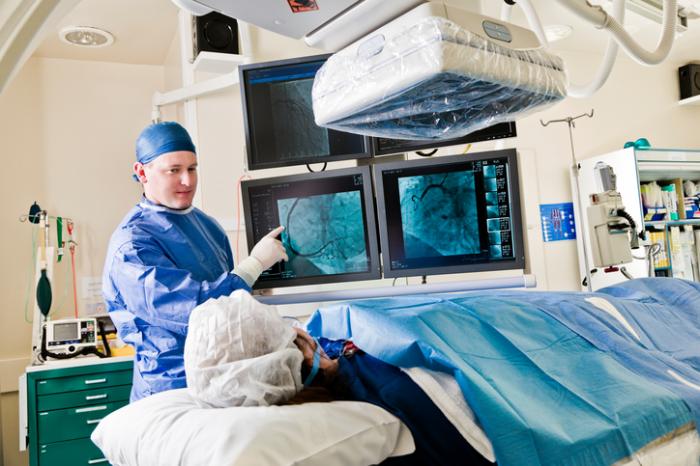Tackling hypertension head-on with modern Cardiology approaches
Wiki Article
Recognizing the Relevance of Cardiology in Modern Medical Care Services
Cardiology plays a crucial function in contemporary health care, particularly as heart problem continues to be the leading reason of death worldwide. Breakthroughs in diagnostics and therapy have actually transformed client care, allowing earlier interventions and enhanced results. The change towards preventive cardiology empowers people to handle their health and wellness proactively. As modern technology remains to develop, the assimilation of cutting-edge services might even more redefine cardiology's impact on public health and wellness, prompting a closer evaluation of arising trends and their ramifications.The Prevalence of Cardiovascular Disease and Its Influence on Public Wellness
Although heart problem continues to be the leading cause of death internationally, its effect expands far beyond specific patients to influence public wellness systems and economic climates. The high frequency of heart problem places a substantial pressure on health care resources, necessitating increased financing for rehab, therapy, and avoidance programs. Public health initiatives have to attend to threat aspects such as obesity, smoking cigarettes, and less active way of lives, which contribute significantly to the climbing incidence of heart conditions.Moreover, the financial concern related to cardiovascular disease is immense, incorporating not just straight clinical costs however additionally indirect expenses associated with lost performance and premature death. Areas encounter difficulties in taking care of these expenses, usually leading to differences in health care access and outcomes. As the population ages and lifestyle-related risks continue to intensify, the seriousness for efficient cardiology treatments comes to be critical. Addressing heart condition is not only a matter of private health and wellness however also an essential public health and wellness top priority.Advances in Cardiac Diagnostics and Imaging Techniques
Recent innovations in heart diagnostics and imaging methods have actually changed the area of cardiology, boosting the capacity to identify and keep track of heart problem. Techniques such as heart MRI, CT angiography, and echocardiography have become progressively innovative, offering in-depth pictures of heart frameworks and functions. These techniques enable the early identification of problems like coronary artery condition, cardiac arrest, and valvular disorders.Moreover, improvements in non-invasive diagnostics, such as wearable technology and remote surveillance devices, have actually empowered patients and doctor. These devices facilitate real-time monitoring of heart rhythms and other essential signs, resulting in prompt treatments. Furthermore, artificial intelligence is being incorporated into imaging evaluation, boosting accuracy and effectiveness in medical diagnosis.Innovations in Therapy Options for Heart Issues
Recent developments in cardiology have actually led to substantial advancements in therapy alternatives for heart disease. These consist of innovative medical strategies that enhance step-by-step end results and arising medications that use brand-new avenues for treatment. As the area advances, these innovations play an essential role in enhancing patient treatment and end results.Advanced Surgical Techniques
Technologies in surgical methods have actually changed the landscape of cardiology, offering brand-new wish for people with heart disease. Minimally intrusive procedures, such as catheter-based interventions, have significantly minimized recuperation times and healthcare facility keeps. Methods like robotic-assisted surgical treatment enhance accuracy, permitting specialists to browse complex anatomical frameworks with higher accuracy. Advancements in imaging innovation facilitate real-time visualization throughout procedures, boosting outcomes. Transcatheter aortic valve substitute (TAVR) exhibits an innovation in treating aortic stenosis, allowing shutoff replacement without open-heart surgical procedure. Furthermore, hybrid techniques that combine medical and catheter-based approaches offer customized solutions for various heart problems. These advanced medical methods not only boost client security but also increase treatment alternatives, underscoring the critical function of technology in modern cardiology techniques.Emerging Drugs and Therapies
As the landscape of cardiology remains to advance, emerging medicines and treatments play a pivotal duty in enhancing treatment options for heart problems. Technologies such as novel anticoagulants and advanced lipid-lowering agents have changed the management of heart diseases, greatly minimizing individual morbidity and mortality. In addition, the development of gene therapies and regenerative medicine supplies promising avenues for dealing with problems previously considered irreversible. Medical tests are consistently exposing the effectiveness of these treatments, pressing the borders of standard therapies. Moreover, the assimilation of digital health modern technologies helps with personalized medication, enabling customized therapy strategies based on hereditary and way of life factors. Jointly, these improvements emphasize the dynamic nature of cardiology, boosting person end results and redefining criteria of care in modern-day health care.The Role of Preventive Cardiology in Patient Treatment
Precautionary cardiology plays an important function in person care by concentrating on the identification of danger factors that add to heart problem. Via lifestyle adjustment approaches and early discovery techniques, doctor can efficiently reduce the incidence of cardiovascular occasions - Cardiology care. This positive approach not just enhances individual end results yet also promotes long-lasting healthDanger Factor Recognition
While heart diseases remain a leading reason for morbidity and death worldwide, effective danger variable identification offers as a cornerstone of preventive cardiology. Identifying threat elements such as high blood pressure, hyperlipidemia, diabetic issues, and family background is crucial for early intervention. Medical care specialists utilize various evaluating techniques to examine these elements, enabling for customized precautionary measures. Additionally, recognizing an individual's way of living options, such as cigarette smoking and physical inactivity, better notifies threat evaluations. This detailed analysis allows medical professionals to establish tailored care strategies aimed at mitigating threats. By prioritizing danger factor identification, healthcare systems can boost client outcomes and decrease the overall burden of cardio diseases, ultimately adding to improved public health and wellness methods and source allowance.Lifestyle Adjustment Methods
A plethora of researches highlights the crucial function of way of living modification strategies in minimizing heart disease danger. These methods incorporate nutritional modifications, enhanced exercise, cigarette smoking cessation, and weight management. By adopting a heart-healthy diet regimen rich in fruits, this website veggies, whole grains, and lean proteins, individuals can decrease cholesterol degrees and blood stress. Regular physical task reinforces the heart and enhances overall cardiovascular health and wellness. Additionally, quitting smoking greatly decreases the danger of cardiovascular disease and enhances recovery rates for those with present problems. Weight administration even more contributes to cardio health and wellness by alleviating other danger variables such as diabetes and high blood pressure. Implementing these lifestyle transforms not only advertises specific well-being but additionally offers as a cornerstone of preventive cardiology in individual treatment.Early Detection Methods
Lifestyle modifications greatly contribute to decreasing cardio condition risks, but they are most efficient when coupled with early discovery strategies. Preventative cardiology stresses the importance of identifying potential heart concerns prior to they rise into serious conditions. Techniques such as high blood pressure surveillance, cholesterol testing, and advanced imaging modern technologies like echocardiograms play essential roles in reviewing cardio health. Biomarkers and hereditary testing likewise boost the accuracy of early detection, permitting for customized preventative strategies. Routine cardiac risk analyses equip health care providers to interfere proactively, possibly avoiding cardiovascular disease and strokes (Cardiology care). By incorporating these early discovery approaches right into regular care, clients can take advantage of prompt way of life interventions and targeted therapies, eventually improving outcomes and boosting high quality of lifeIntegrating Innovation Into Cardiology Practices
As advancements in technology remain to improve numerous fields, the integration of ingenious devices and systems into cardiology methods has become necessary for improving person care and end results. Telemedicine platforms permit cardiologists to monitor patients remotely, boosting accessibility to care while reducing the worry on health care centers. Wearable devices, such as smartwatches, allow continual heart price surveillance, informing both individuals and physicians to possible issues in real-time. Furthermore, man-made knowledge (AI) is being utilized to assess vast amounts of cardiac information, assisting in very early medical diagnosis and individualized therapy strategies. Advanced imaging methods, including 3D echocardiography, enhance visualization of heart structures, leading to a lot more accurate interventions. Electronic wellness records (EHRs) enhance client information monitoring, making sure that cardiologists have instant access to essential information. With each other, these technological developments are transforming cardiology, promoting positive monitoring and improved health and wellness results for individuals with Home Page cardio problems.The Importance of Individual Education and Interaction
Patient education and learning and engagement play a crucial function in the administration of cardiovascular wellness. By equipping clients with knowledge regarding their conditions, treatment choices, and lifestyle changes, health care providers encourage people to take an active duty in their care. This proactive method can result in boosted adherence to recommended medications, nutritional adjustments, and workout programs, inevitably reducing the threat of complications.Engagement additionally cultivates a strong patient-provider partnership, motivating open communication and count on. When individuals feel educated and entailed, they are most likely to voice concerns and ask concerns, which can bring about better professional end results. In addition, instructional resources, such as workshops or digital platforms, can improve understanding and promote self-management methods. In general, focusing on patient education and learning and involvement is necessary for enhancing cardio wellness, enhancing lifestyle, and decreasing medical care costs connected with heart diseases.Future Patterns in Cardiology and Their Prospective Impact

Often Asked Concerns
What Way Of Life Adjustments Can Decrease Heart Problem Risk?
The existing question addresses way of living adjustments that can considerably minimize cardiovascular disease risk. Cardiologist near me. Taking on a well balanced diet plan, taking part in normal exercise, maintaining a healthy and balanced weight, taking care of anxiety, and avoiding tobacco can especially improve cardiovascular health and wellnessHow Can I Acknowledge Very Early Indications of Heart Problems?
Acknowledging very early signs of heart problems entails monitoring signs and symptoms such as breast discomfort, lack of breath, exhaustion, and irregular heartbeat. Prompt understanding of these signs can trigger needed medical analysis and intervention for better end results.What Are the Distinctions Between Cardiologists and Cardiac Surgeons?
The distinctions in between cardiologists and cardiac cosmetic surgeons lie in their roles; cardiologists largely manage and identify heart disease with non-invasive approaches, while heart surgeons do operations to fix structural heart problems. Each plays a crucial, distinctive duty.
Just how Commonly Should I Get My Heart Health Checked?
The regularity of heart medical examination varies based on individual threat elements. Usually, adults must undergo evaluations each to two years, while those with present conditions might call for more frequent assessments as suggested by health care professionals.What Duty Does Genetics Play in Heart Problem Danger?
Genetics significantly influences cardiovascular disease risk, with familial patterns showing acquired conditions. Specific genes can predispose individuals to hypertension, cholesterol problems, and other cardiovascular problems, highlighting the relevance of genetic screening in evaluating heart health. Heart illness remains the leading reason of fatality internationally, its effect prolongs much beyond private people to influence public health and wellness systems and economic climates. Public health and wellness efforts need to attend to threat elements such as weight problems, smoking cigarettes, and sedentary lifestyles, which add considerably to the climbing incidence of heart conditions.Moreover, the economic concern associated with heart illness is immense, encompassing not just straight medical expenses however also indirect costs connected to shed efficiency and premature mortality. Precautionary cardiology plays a necessary duty in individual care by concentrating on read review the recognition of danger elements that contribute to heart illness. Artificial intelligence (AI) and maker understanding are improving diagnostics and client tracking, allowing very early detection of heart conditions. The distinctions between cardiologists and cardiac doctors lie in their functions; cardiologists mostly handle and detect heart problems with non-invasive techniques, while cardiac doctors carry out surgical procedures to fix architectural heart issues.Report this wiki page